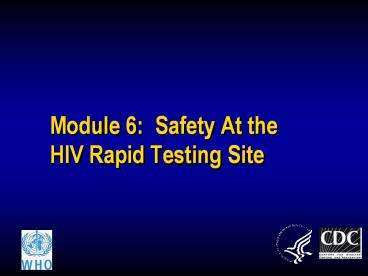Module 6: Safety At the HIV Rapid Testing Site - PowerPoint PPT Presentation
1 / 27
Title:
Module 6: Safety At the HIV Rapid Testing Site
Description:
Adhere to personal health and safety practices. Maintain a clean and organized workspace ... WHO Laboratory Biosafety Manual. Lab workers. Health workers ... – PowerPoint PPT presentation
Number of Views:37
Avg rating:3.0/5.0
Title: Module 6: Safety At the HIV Rapid Testing Site
1
Module 6 Safety At theHIV Rapid Testing Site
2
The Lab Quality System
3
Why Is Safety Important?
- Coming in contact with human blood or blood
products is potentially hazardous. - Safety involves taking precautions to protect you
and the client against infection.
4
What Else Needs Protection?
- Other people who may come in contact with testing
by-products - Protect integrity of test products
- Protect environment from hazardous material
2.1
5
Learning Objectives
- At the end of this module, you will be able to
- Adhere to personal health and safety practices
- Maintain a clean and organized workspace
- Disinfect and dispose of infectious materials
- Take appropriate actions following accidental
exposure to potentially infectious specimen - Follow written safety procedures and keep proper
safety records
6
Content Overview
- General safety practices
- Work habits (personal, work space, material)
- Proper disposal of sharps and waste
- Disinfection of work areas
- Safety documentation
7
Universal or Standard Precautions
Every specimen should be treated as though it
is infectious
8
Apply Safety Practices Throughout the Testing
Process
- Before Testing (Pre-analytical)
- Specimen collection
- Specimen preparation
- Specimen transport
- Testing (Analytical)
- Testing
- After Testing (Post-analytical)
- Disposal
9
Develop Personal Safe Work Habits
- Wash hands before and after testing each patient
- Wear a fresh pair of gloves with each patient
- Wear lab coat or apron
- Dispose of contaminated sharps and waste
immediately after testing
10
Develop Personal Safe Work Habits (Contd)
- Pipetting by mouth is strictly forbidden
- Never eat, drink or smoke at the test site
- Keep food out of the laboratory/testing site
refrigerator
11
Maintain Clean Orderly Work Space
- Keep work areas uncluttered and clean
- Disinfect work surfaces daily
- Restrict or limit access when working
- Keep supplies locked in a safe and secure area
- Keep emergency eye wash units in working order
and within expiry date
Biohazard
12
Take Precautions to Avoid Needle Stick Injury
- What can cause needle stick injury?
- Lack of concentration
- Inexperience
- Lack of concern for others
- Improper disposal of sharps
13
Drop Used Sharps in Special Containers
WASTE
14
Dos and Donts Sharps and Waste Containers
- Do Not break, bend, re-sheath or reuse lancets,
syringes or needles - Do Not shake sharps containers to create space
2.4
15
Dos and Donts Sharps and Waste Containers
Whats wrong with this picture?
16
Never Place Needles or Sharps in Office Waste
Containers
2.4
17
Sharps Containers Must Be
Placed near workspace Closed when not in use
Sealed when ¾ full
18
Policy for Handling Sharps
- User responsible for disposal of sharps
- Must dispose of sharps after each test
- Must place sharps in sharps boxes
- Do not drop sharps on the floor or in the office
waste bin - Place sharps container near your workspace
- Seal and remove when box is ¾ full
- Incinerate all waste
19
Incineration of Waste
- Incineration is burning of contaminated waste to
destroy and kill micro-organisms. - Incineration
- Is effective against potential re-use
- Protects environment
- Must be supervised
20
Disinfect Work Areas with Bleach
- Disinfection
- Kills germs and pathogens
- Keeps work surface clean
- Prevents cross-contamination
- Reduces risks of infection
21
Different Cleaning Jobs Require Different Bleach
Solutions
- General lab use - Hypochlorite Solutions
You should have 10 bleach readily available at
your test site.
WHO Laboratory Biosafety Manual
22
Making a 10 Bleach Solution
Referred to as a 1/10, 110, or 5,000 ppm bleach
solution
23
In Case of a Spill or Splash
- Wear clean disposable gloves
- Immediately and thoroughly wash any skin splashed
with blood - Large spills- Cover with paper towels and soak
with 10 household bleach and allow to stand for
at least 5 minutes - Small spill - Wipe with paper towel soaked in 10
bleach - Discard contaminated towels in infectious waste
containers
24
In Case of an Accident
- What types of accidents can happen?
- Potential Injury, i.e., needlesticks, falls
- Environmental, i.e., splashes or spills
- Equipment damage
- What should you do?
- Report to supervisor immediately
- Assess take action
- Record using form
- Monitor situation
25
Action Plan for ImplementingSafety Practices
- Identify hazards
- Establish and implement safety polices and
procedures - Conduct safety specific training
- Must be a priority
- Communication is key
- Perform regular audits or assessments
26
Safety References
27
Summary
- What is safety? Why is it important?
- What does bio-hazard mean?
- What is the universal precaution you must take
when dealing with specimens? - What are some examples of safety practices
related to personal habits? Work space? - What are the rules related to handling sharps and
waste? - How do you prepare a 10 bleach solution?
- What do you do if there is a spill?
- What do you do when an accident occurs?































